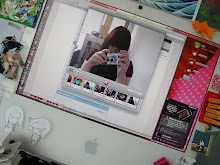I've spent a lot of time in the project exploring different possible technologies to use, including hacking wiimotes, Arduino, RFID, and colour tracking. I explored all the different strengths and weaknesses of each tech: colour tracking being pap in low light, and interfered with by similarly coloured objects, wiimotes being temperamental little things and prone to errors in Processing in my experience, Arduino being one of the most appealing technologies I looked into, but all the fun components get a little bit expensive on my budget, and RFID only reading tags, not tracking. I'm now going to look into the uses of the two technologies that I have decided to use, and the potential uses of what I have created using them.
When I first started this project I was quite interested in tracking the users around the space, which still interests me, but as I progressed through the project I found myself becoming more interested in creating a tactile interface, and the technologies that were best to create one were what I ended up using - Arduino and RFID tagging. The RFID tagging allowed me to create physical objects that could be recognized by the computer, allowing the real world to interact with the data in the computer. The Lilypad allowed me to create objects that were not only clever and glowy and wow, but allowed me to create objects that the user wants to pick up and interact with. The knitting also helped with that, people seem to be comfortable with the objects and find them familiar because of the way they are made.
"In of itself, I don't find RFID that exciting. When it's connected to a greater network (e.g. a database, the web, other intelligent devices, etc.) , that's when it can get really interesting." - Doria Fan
Doria fan uses RFID tags to create objects that are imbued with personal histories, without overpowering the object with technology. Her RFID enabled medical history bracelets are still bracelets, the technology does not interfere with the practicality of the object.

The tags inside the medical bracelets contain activate a link to the patients online medical history, making it a beautiful but practical object, containing the wearers personal history.
iTea is another RFID tagging system which uses the internet to bring up data.

Dropping your conference pass in a tea cup scans the internet for data about you. Some information is taken off a social network site, some is googled, allowing the user to see their personal profile made by the internet, whether it's true or false.
To sum it up, the wonderful thing about RFID is that it enables an object to be two different things. It remains the object it was or was intended to be, the bracelet is still a bracelet, the big wooly cloud is still a big wooly cloud, but it allows the object to take on a different aspect as well. It becomes an object that can interface with the digital world, and can bring up data that not only relates to the object, but adds to its meaning.
I've looked into the uses of the Arduino lilypad before, so this bit will be a little bit shorter. Basically, after my experimentation and research in my last project, which focused on the lilypad being a technology to create wearable textiles, I found myself wanting to experiment with it more in a different context. I have researched in toy hacking as part of this project, looking into the creations from the mediamatic workshop, which while were brilliant examples of the toys getting new functionalities, the objects lost some of their identities as toys, what with the wires poking out of them. Granted they were prototypes from a workshop, but I wanted to create objects that were still objects. My little wooly friends were designed to be wired up, and buzzing around around the place and blinding people with ultra bright LEDs, but I wanted them to retain the element of familiarity and softness brought about by creating them by knitting, even before i knew I was going to knit them or reminded myself how to knit. By using the lilypad I was able to make them into "shiny wow wow's", but by using soft circuits was able to keep them as approachable objects.
So then, how could what I have made be used? My program, even there are around a thousand lines in it, is rather simplistic. It gets the feed, matches it up with the RFID tag and spits it out to the screen. And makes some swirly animations. All rather nice but the data it's getting, and the way it gets it could be used in other ways. Some examples are in the RFID examples above, using the technology to personalise objects and drag in data from the internet. The use of the weather data itself lends it to be used with a mapping system like google maps, returning the data to it's geographical context, and reminding people who don't have such a detailed map in there heads of where places are in relation to each other. The weather feed could also be used in conjunction with other feeds, perhaps used with flickr, to create a link between a weather state and the most recent and geographically appropriate geotagged photo uploaded, creating a visual representation of the weather that is more closely related to the data than my swirly graphics.
There are many things it could be used for i suppose, now that I've figured out how to do the simpler parts (getting the feed, getting it to the screen, using RFID tags), I plan to keep exploring the possibilities.




No comments:
Post a Comment